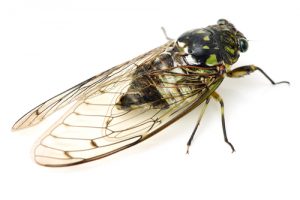Cicadas Won’t Eat Your Plants
By Chris Williams on August 9, 2012.
Q. I’ve just noticed the first of those brown, crunchy skins that you see on tree trunks. I think they belong to those noisy cicadas. Is there anything we can do about cicadas? Don’t they feed on trees?
A. Neither the cicada nymphs nor adults cause any feeding damage to trees or other plants. In years when a large brood of cicadas emerges, there can be noticeable browning and “flagging” of branch tips as a result of egg laying however. The female uses her ovipositor to saw a slit in the bark of small twigs and deposits several eggs in each slit. Most experts consider this to be a harmless tip pruning which does not hurt mature trees. Young trees can be damaged by egg laying in years when there is a heavy outbreak of periodical cicadas.
In our northeast region, there won’t be any large broods of periodical cicadas hatching this year so any damage to trees should be barely noticeable. Periodical cicadas are wonderful, amazing creatures because the nymphs spend 17 (or 13) years feeding on roots underground before they make their appearance as adult cicadas! There are 15 different 17-year cicada broods in the U.S., and several 13-year broods. Most of our area won’t see a large periodical cicada emergence again until 2018.
But we do have smaller numbers of another type of cicada that emerges every summer. Annual cicadas have a similar, but much shorter, life cycle. Annual cicadas are greenish with black markings and are larger than the all black periodical cicadas.
Annual cicadas are called “dog day cicadas” because they make their appearance every year in mid to late summer during the dog days when the weather is really hot. When the underground nymphs are ready to emerge, they burrow to the surface (leaving pencil-sized holes), climb onto tree trunks or other surfaces, split their nymphal skins and emerge as winged, adult cicadas. Adult cicadas buzz in the treetops for several weeks as they mate and lay eggs in the tips of branches. Hatching nymphs drop from the trees and burrow into the ground to begin years of waiting for their day in the sun.
The best thing to do about cicadas is to marvel at them and enjoy these dinosaurs of the insect world. They provide food for birds and other animals, entertainment for kids, they don’t bite or sting, and they will be gone in just a few weeks.
